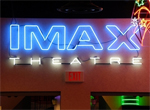Ask typical movie goers for the definition of an IMAX Theatre, and they will likely give you an unclear response about a big screen and loud sound. On these points they would be right – but only as a vague definition. You see, the IMAX Corporation has gone to great lengths to make sure that every IMAX-certified theatre actually delivers what they consider to be “The IMAX Experience ®.” They want to make sure that the IMAX brand truly means something to consumers – something more than “a big screen and loud sound.” And if that IMAX brand is to mean anything, then every IMAX Theatre must deliver the same high quality movie experience from Los Angeles to New York to your hometown, and so on. This is achieved through the process of IMAX certification, which involves enforcing stringent specifications in two realms: film production and theater design.
The film production standards are fairly straightforward and widely publicized: At a quick glance, the filmmaker must shoot on 70mm film (at a 1.44:1 aspect ratio) and capture the audio in 6-channel surround sound (somewhat similar to the home theatre standard of 5.1 surround sound, where the 5 represents the different channels of surround sound, and the .1 represents a dedicated subwoofer channel.) The theatre technology specifications are equally clear-cut: each must be equipped with IMAX-certified projectors and screens and each must use IMAX-certified surround sound systems.
The cinema performance standards, however, are a bit more intangible (some would consider this the unseen “secret” aspects of the design) and they can only be met by verifying the theatre’s acoustical performance levels in three areas, namely: reverberation time, noise isolation, and background noise. As acoustical consultants, our job is to work with the local architect to make sure the acoustic standards are met in each of the three areas. In other words, we take the risk out of the design for the cinema owner and IMAX, and review the design ahead of time so that cinema owners will garner that elusive IMAX-certification, the “holy grail” of cinema status symbols, on opening day.
Reverberation Time is the measurement of sound reflections in a space, and IMAX requires a significant amount of “acoustical deadness” and sound absorbency. The goal is for the sound (which has already been post-processed and mixed by the filmmakers) to reach the listener’s ears with very few reflections and remain uncolored by the room itself. The IMAX criterion calls for a very short reverberation time. The key design factor is engineering the proper amount of acoustical absorption for the room’s surfaces so it performs within the specifications.
The second consideration is Noise Isolation, which seeks to block (rather than absorb) sound from penetrating into or out-of of the IMAX theatre. It is a reference of how much isolation exists between the theatre and the adjacent spaces.
The final acoustical specification is Background Noise, which measures how much ambient sound exists within the space. Many times this involves designing noise mitigation for mechanical units and HVAC systems throughout (and without) the facility. The sum of the background noise is often referred to as the “noise floor” and is measured in Noise Criterion (“NC”) levels. An IMAX Theatre will have to perform much better than the typical cinema level of NC-35. Miss the boat in any of these three areas, and your ship is sunk.
So, in fact, it is possible to build a very large theatre, and buy all the right IMAX technology, but still not be permitted to show IMAX films. Without the verification of the criteria listed above, cinemas can end up with a huge investment and nothing to show for it other than a big ol’ (empty) theatre. So, in this case, certification really means something. Maybe the secret of The IMAX Experience ® isn’t primarily in the big screen and loud sound, but in the acoustical performance and the “secret” unseen criteria measured by acousticians?

Alright, just read this article, found it on my usual surfing tangents. Cheers.
You need to post more often you do a good job
And this is the reason I like http://www.acousticsbydesign.com. Incredible post.